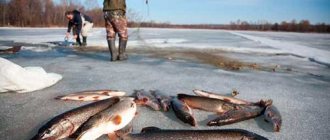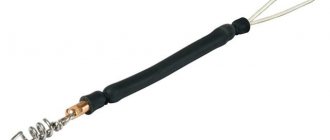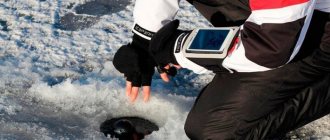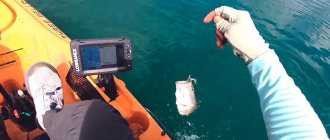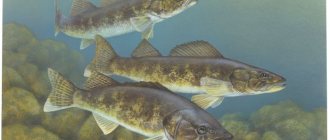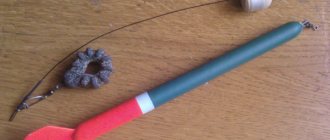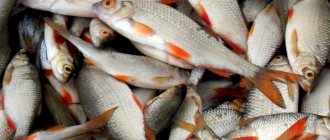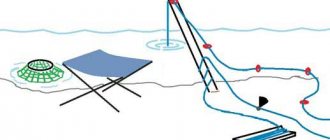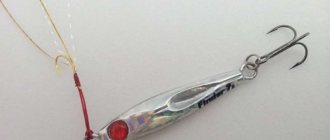How to make a scarf for fishing
Headscarves are screen tackles. They are lowered into the water for a short time, then rise, after which the fish entangled in the screen net are collected.
TV - pieces of nets of 4-gonal shape, having sinkers and a float. The scarves have a 3-corner shape. They are mainly used during winter fishing, when it can be easily pulled into the hole.
Making such a fishing net yourself is quite easy.
Stages of work
You should purchase a piece of net with the required parameters from a fishing store; you may also need a braided cord. The mesh sizes should be selected in accordance with the type of fish that will be caught in this way.
It is necessary to prepare a piece of reinforcing rod with a diameter of about 4 mm; for fishing in a river current, a rod with a diameter of 1 mm may be needed.
It is necessary to spread the net fabric over a large surface and mark the final cells on 2 sides using rope or electrical tape, taking into account allowances of at least 2 cells for fastening. Then you need to calculate the number of cells along the length and mark the middle one.
Then, using sharp scissors, you need to cut off the corner of the edge of the canvas to the final cells on 2 sides. The next row should be 2 cells larger than the previous one, 1 on each side. As a result, a 3-coal sheet with equal sides should come out.
Final stage
It is necessary to apply about 5 notches to the ends of the reinforcement rod using a chisel at a distance of 2 cm. Then you need to thread a nylon thread into each cell from the bottom of the network fabric. The thread should be secured to the notches on the side with knots so that there is a slight sag of 5 cm at the edge of the net. The thread should be parallel to the reinforcing rod, there should be no twists.
Then you need:
- divide the length of the edge from the bottom of the net fabric into 4 equal parts,
- mark cells.
Then the nylon thread is fixed in these cells to the reinforcement rod.
It is necessary to thread the vein upward into the cells on one side of the fabric. Then this vein needs to be threaded down the other side. The vein should be secured to the reinforcement rod in the place where the lower edge is secured on both sides.
It is necessary that the vein passes through all the cells of the network fabric up and down. It is necessary to leave about 9 cm of veins on the upper part of the canvas to connect the fastening loops.
Finally, you need to tighten the top loop of the “kerchief” with an ordinary knot.
2 A simple and quick way to knit a fishing net like a TV or scarf
A video about how to properly weave a fishing net in the shape of a triangle to make a fishing device “TV” or “kerchief”.
What is tackle
This is a triangular-shaped screen tackle, the main task of which is to entangle fish in a short time in the water. Thanks to its convenient shape, it is widely used in winter fishing. It consists of a frame made of metal and a mesh mesh attached to it, and the size of the cells depends on the size of the fish that is caught with this gear. The weight of the frame serves as a sinker in the water.
Fishing tackle "kerchief" is widely used in winter fishing because of its convenient triangular shape, which easily fits into the hole. Before you start fishing, the fishing area is well-fed, and only then do they begin to install the gear. After feeding, the tackle is attached to a rope and immersed in the hole. The success of fishing with a scarf depends on the fishing conditions: the active peak of the bite will be at the beginning and end of winter, in severe frost it will be difficult to catch anything with it.
Tips for fisherman: How to wind fishing line on a winter fishing rod - How to best use
A scarf is a very useful tackle for every fisherman.
Let's consider what is required for manufacturing, and how to make a scarf for fishing with your own hands will be described in the next section:
- fishing net - the size of the mesh depends on the fisherman, the choice is individual;
- 5 mm wire - it is necessary to create a frame;
- nylon thread, thick fishing line.
Use scarves at the very beginning of winter, when the ice has just hardened. Fishing at this time is much more effective, since during this period they are looking for a place to stop, but be careful - fishing on thin ice can be dangerous.
It is necessary to thread the vein upward into the cells on one side of the fabric. Then this vein needs to be threaded down the other side. The vein should be secured to the reinforcement rod in the place where the lower edge is secured on both sides. It is necessary that the vein passes through all the cells of the network fabric up and down. It is necessary to leave about 9 cm of veins on the upper part of the canvas to connect the fastening loops. Finally, you need to tighten the top loop of the “kerchief” with an ordinary knot.
Headscarves are screen tackles. They are lowered into the water for a short time, then rise, after which the fish entangled in the screen net are collected. TV - pieces of nets of 4-gonal shape, having sinkers and a float. The scarves have a 3-corner shape. They are mainly used during winter fishing, when it can be easily pulled into the hole. Making such a fishing net yourself is quite easy.
Stages of work
You should purchase a piece of net with the required parameters from a fishing store; you may also need a braided cord. The mesh sizes should be selected in accordance with the type of fish that will be caught in this way.
Useful video
Next, let's watch a video about park fishing with a kerchief in winter:
The scarf has proven itself to be an effective means of catching fish in winter conditions. In skillful hands, in a catchable place, with properly prepared bait, it works great even in unfavorable weather conditions, when ordinary tackle equipped with a hook is unproductive.
But we must never forget that a real, correct fisherman never takes an excessive amount of fish, especially fry, which must subsequently grow up and give birth to their offspring. Everyone needs to remember about the safety of fish stocks in our reservoirs, and then our children and grandchildren will also be able to go fishing, enjoying their catch.
klevyj.com
Application of bait
A scarf is a fairly small net, which means that some additional factor is needed to attract fish to the place where the net is installed. Along with this gear, you almost always have to use one or another version of bait mixtures
It is important to take into account that the composition of these mixtures will differ significantly depending on the season.
In open water, a light mixture with a pronounced aroma of spices will work well (this smell is attractive to most types of fish). In this case, you should simultaneously use both highly moistened bait balls, which will work when they fall to the bottom, and under-moistened ones, which will create a trail in the water column that attracts fish. In order to increase the effectiveness of bait, animal components of maggots, red dung worms or food bloodworms can be added to its composition.
Important! You can use the technique of feeder athletes: cut the red worm or maggots with scissors, and only then add it to the bait
This smell can attract the attention of even the most passive fish.
Winter varieties are usually less nutritious, their aroma is much weaker, and the color is usually dark. A strong spicy smell or bright colors in winter can, on the contrary, scare away fish from the place where the scarf is installed. A winter version can also be made from summer bait simply by adding a sufficient amount of soil.
You should also pay attention to the method of delivery of bait. In winter, it is better to use special feeders that allow you to release bait directly to the bottom of the reservoir.
In the summer, the feeding process is somewhat simpler - ordinary bait balls are quite enough.
Fly fishing
In winter, grayling can be caught using a summer bait such as an artificial fly. It completely imitates real insects, which, of course, are not found in the cold season, but the fish quite willingly bites on such bait. When fishing with a fly, it is usually used as a second bait, clinging on a short leash slightly above the jig. The jig can also be replaced with a simple weight of appropriate weight attached to the end of the main fishing line. This type of equipment is called a “garland”. Hooks on flies should be small, and colors should be selected according to the same principle as for jigs - depending on the variety of grayling.
Fishing in winter with a scarf
A real fisherman will not sit at home even in severe frost, but the fish do not always meet his desires. Sometimes it is caught, sometimes it is not caught.
And in winter, sometimes you really want to sip hot ears! Therefore, many people put winter fishing rods aside and switch to fishing with non-sporting, but effective gear. For example, a scarf.
With this simple design you can catch a wide variety of fish: fish soup, live bait, and sometimes even pike. What kind of gear is this? And what is good about fishing with a scarf in winter?
Net
By and large, a scarf is a network. Only a very small one, so it’s hard to call it a poacher. The working element of the scarf is a piece of fishing net in the shape of a regular triangle with sides up to 1.5 meters long.
You can cut one out of an old torn fishing net, you just need to find a surviving section in it. The size of the cells can be different; it is selected depending on what kind of prey the fisherman is targeting.
To replenish stocks of live bait, a mesh with cells of 18-20 mm is suitable, and if your ambitions are off the charts, then you can install a more serious canvas - 40-50 mm.
Frame
An equally important component of the scarf is a rod made of metal wire, which acts as a sinker. He not only lowers the tackle to the bottom, but also puts it in the working position, that is, vertically
To prevent such a frame from slipping out of the canvas, ears are made at its ends, and on it itself there are special notches that will securely hold the fixing line or nylon thread. For the scarf to work properly, the mesh at the point of attachment to the wire must sag a little.
The ends of a thick fishing line (nylon thread) go to the top of the triangle and are tied together. At the edges of the frame, loops are made for the rope, on which the tackle will be lowered into the hole.
As you can see, there is nothing complicated in this design. To make a scarf for winter fishing, just find an old net, a piece of wire with a diameter of 3-4 mm, a skein of nylon thread and twine. A little effort and she's ready.
Kerchief in action
Anyone can master the technique of fishing with this catchy tackle, even a person who has never been interested in fishing before. True, his catches will be smaller, since he does not know how to find fish sites.
Where to fish
It is with the search for winter havens of underwater inhabitants that fishing with a scarf in winter begins. Usually these are deep holes, called wintering holes, but this approach is relevant for the middle of the cold season, when the fish practically do not move. But when there is first ice and closer to spring, you should look for fish in the same places where they were caught well in the summer.
A big catch and a great mood can be given by installing one or several scarves near the shore, among the remnants of reeds and other vegetation.
When a suitable location has been determined, you can begin drilling holes. Even if you only have a couple of scarves in your arsenal, there should still be several holes.
After the tackle has been in each of them, it will become clear where it is better to fish.
Feeding
The scarf is perhaps the only net that is used for fishing with bait. This will seem nonsense to sports fishermen, but without complementary foods it is really ineffective. A one-and-a-half-meter canvas, tapering at the top to zero, takes up a tiny space, so the fish have to be literally lured into it.
As bait, fans of this tackle use various mixed feeds, steamed wheat or pearl barley, breadcrumbs and even ordinary soaked bread.
It would be a good idea to mix all of the above, then the bait will attract different types of fish.
If you add components of animal origin (food bloodworms, crushed worms) to the mixture, you can count on catching ruffs and perches.
Fishing technique
When the hole is baited, the tackle is lowered into it. It is best to install it at the bottom, especially since there is attractive food there, although sometimes due to lack of oxygen the fish can rise to the middle and upper horizons. A stick slightly longer than the diameter of the hole is tied to the free end of the rope, which, after installation, is laid across the hole in the ice.
It is covered with brushwood on top, and then everything is covered with snow so that potential prey is not frightened by the light spot above its head. Some fans of scarf fishing disguise the end of the rope for another reason, especially when they leave several such gear on a pond for a long time. This way, fishery inspectors or “colleagues” who are greedy for other people’s property will not be able to see and take them away.
Fishing technique with a scarf
Fishing with a scarf from under the ice is not considered a difficult task. Any beginner can master this method within a few trips to the pond. In this case, most of the time will be spent on searching for fish sites, and not on improving the skills of installing a scarf.
The key to successful fishing with mesh tackle is proper feeding of the fish. Any store-bought bait is suitable for this, as well as breadcrumbs, steamed grains, mixed feed, etc. In each body of water, the fish prefers its own set of ingredients in the bait. You can’t do winter fishing without an ice drill. On first ice, you can make holes in a frozen reservoir using an ice pick. But when the ice thickness exceeds 10-15 cm, there is no alternative to an ice auger. After drilling the holes, you need to put the prepared bait in a special feeder. As soon as the dose of food reaches the bottom surface, you need to shake the feeder sharply so that it opens. After the feeding operation, a scarf is lowered into the hole
It is important to position the tackle so that the base rests on the bottom and the entire canvas is stretched. The end of the cord is tied to a reel or stick, which is located across the hole
If the tackle is left overnight, the hole should be covered with snow.
The kerchief is considered a very catchable winter tackle on the first ice and on the last ice. It allows you to catch the required amount of fish with minimal cost.
Using a scarf for fishing is simple:
- First of all, you need to decide on the place where the fishing will take place. In cold weather, all types of fish gather in wintering pits and stop actively swimming under water.
- Choose bait, it is better to take several types of mixture. Also take equipment for drilling a hole; if the ice thickness is more than 10 cm, then you cannot do without an ice ax.
- Make a hole and apply bait.
- After this, lower the scarf under the ice and connect it with a rope so that the tackle does not go under water.
- Mask the hole with snow and tree branches; this must be done so that the fish does not get scared of the fishing structure and does not go far from the hole made.
The technique is very simple and any novice fisherman can master it. The main condition for successful fishing is searching for fish sites. Before the start of winter, fish accumulate in wintering pits and stay in one place, not actively moving around the reservoir in search of food.
- One of the components of the conditions for catching fish is the moment of baiting the fish, for which you can use ready-made bait mixtures or prepare it yourself. For each reservoir, this can be its own set of components such as breadcrumbs, mixed feed, steamed grains of various crops, etc.
- An indispensable assistant for a fisherman in winter fishing is an ice auger. If the ice thickness does not exceed 10 cm, then the holes can be made with a small sharp crowbar, and if the ice thickness is more than 10 cm, then only with an ice screw. After preparing the holes, you can begin the process of feeding the fish. To do this, take a special feeder, place bait in it and lower it to the bottom, where the feeder opens and leaves its load at the bottom.
- After feeding the fish, a scarf on a cord is lowered into the hole, which is attached to a reel or stick. They are laid across the hole, and brushwood and snow are poured on top, after which you can move away from the hole so as not to frighten the fish with your presence. The scarf is effective at the beginning and end of winter and allows you to catch a small number of fish with minimal cost.
We invite you to watch a video on how to independently, simply and quickly tie a “kerchief” or “TV” type tackle.
In the same place, we recommend a video of how fishing takes place in winter with such gear as a scarf.
The use of certain gear presupposes a certain limit to the fish catch, which could preserve fish stocks for the future. No need to take more fish than you can eat at one time
Much attention should be paid to “little things”, which it is advisable to release rather than feed to cats
Source
Subtleties of proper fishing
Fishing with a scarf is a very exciting activity that interests not only experienced fishermen, but also beginners who want to experience new emotions and get vivid impressions. Fishing with this method is very simple, so even an inexperienced person can easily master the basic subtleties of casting techniques and further operation of the gear. The key to successful fishing is determining the current location of the fish. To do this, you need to at least understand the peculiarities of its behavior in winter, taking into account the many years of experience of colleagues and local fishermen.
It is no secret that in the first days of winter, the inhabitants of the depths stay in wintering pits almost without leaving them. To quickly determine their location and then go fishing successfully, you should follow these recommendations:
Good feeding of a promising hole is already half the battle
It is important to properly feed the appropriate area, using proven store-bought products or formulations created according to your own recipe. The second option is more interesting, because it allows you to create good bait for specific conditions
They may contain breadcrumbs, mixed feed, steamed wheat grains, all kinds of cereals, plant and animal components, etc. Comfortable winter fishing is impossible without a good ice auger. Of course, if the thickness of the ice in the chosen place does not exceed 10 centimeters, then it can be cut with a sharp crowbar, although it is not entirely safe to be on such a surface. If the ice is much thicker, then it is advisable to use a powerful ice drill. After making sure that all the holes are prepared, you can start feeding the fish. To do this, you need to take a special feeder where the complementary food is placed, and lower it to the bottom, where the load will begin to crumble and create a cloudy cloud that can arouse the interest of even the laziest prey. After successful feeding, you can place a scarf in the hole, tied to a reel or stick using a strong cord. With a passive fishing method, such fixing elements can be sprinkled with snow and moved to the side so as not to scare the fish. Experts recommend using a scarf for fishing only at the beginning of winter and during the last ice, since during this time period the chances of a successful catch are maximum and costs are reduced to a minimum.
https://youtube.com/watch?v=aGV2-z5dxyo
Kerchief tackle is an interesting way to catch fish during winter fishing and a quick way to get live bait for girders
With such gear as a scarf, you can catch, for example, live bait in winter, or fish directly on the grill. In just one cast you can catch more than one specimen, without any unnecessary movements.
Everyone should understand that you can’t catch fish from the pond without effort. Therefore, it is necessary to be able to use such equipment and know how to use it correctly.
Fishing with a capsicum during winter fishing, like other gear, has its own approach and tricks. And excitement and interest manifests itself when you find a catchy place and get a hefty catch onto the ice.
A kerchief is a simple winter fishing tackle and a way to quickly catch live bait for girders
Some will consider the headscarf to be poaching gear. And to some extent they will be wrong. I’ll say right away that such kerchief gear is not included in the list of prohibited items.
But there are individuals who, for the sake of profit, often neglect and take advantage - they put a scarf in large quantities (from 5) and fish with it in the wrong places (wintering pits).
This is no longer a completely fair way of winter fishing.
What is a scarf tackle for winter fishing?
In the summer, “screen” or “TV” – whatever you like, and in winter – “kerchief”.
Can you guess what we're talking about?
Yes, this is not a sportive form of fishing! Part of the mesh is used.
If in summer there are no obstacles in the form of ice, so summer copies of scarves are made rectangular, then in winter it is difficult to lower and lift such tackle into the hole.
A scarf is a triangular piece of fishing net (an isosceles triangle - hence the name of the net - it looks like a lady's headscarf), the lower part of which is tied to a steel rod.
Thick steel wire serves as a sinker. Due to this, the scarf is quickly delivered and pulled vertically.
A rope for fishing or a thick fishing line is placed along the other two thighs-sides of the triangle.
The dimensions of the triangular mesh are no more than 1.5 meters on each side.
The grid cells are selected depending on the fishing conditions. Small baitfish are caught on a net with cells from 10 to 18 mm, and larger fish are caught on a net with cells up to 50 mm.
Where and when can you fish with a scarf during winter fishing?
It is best to catch winter fish with a scarf on the first ice and closer to spring - on the last ice. In the wilderness you won’t catch much with such gear.
In winter, a scarf can also serve as a supplement to the main types of fishing.
You need to catch such gear in places where fish accumulate - in holes and cliffs. Fry are caught with live bait in the upper layers, and larger fish are caught at the bottom.
Do-it-yourself scarf for winter fishing - quick and easy to make
Honestly, such winter gear as a scarf can be purchased in a store for little money - from 100 to 350 rubles.
Well, you can make a scarf yourself quickly and without problems.
To make your own headscarf for winter fishing you will need:
- steel rod with a diameter of 5 mm,
- fishing net with mesh 10-50 mm,
- nylon rope or thick fishing line (0.7-0.8 mm).
Well, a tool suitable for making a scarf.
1. Cut out an isosceles triangle from a piece of net, the sides of which are 1-1.5 meters long.
2. Next, the lower side is attached using knots to a steel bar.
3. We tie a fishing line to one end of the rod and thread it through the mesh cells of one of the edges of the triangle.
4. At the end of the fishing line we form a loop through which the nylon rope passes to the other end of the steel bar.
How to fish with a scarf during winter fishing: tactics and principles of fishing
There is nothing difficult about fishing with a scarf during winter fishing.
The most important thing in fishing tactics with such gear is to feed the fish correctly.
If there is a current, then several holes are drilled for feeding. The bait should be, like all winter bait, loose, creating a cloudy cloud.
Downstream, a working hole is drilled into which the gusset is lowered.
We fill this hole with snow and small branches. Then you should move away from the hole so as not to scare the fish.
Every hour or half an hour you can check the tackle for catches.
And I would also like to draw attention to the fact that fishing for us is a hobby, not profit. Original article here: Scarf for catching fish during winter fishing. Original article here: Scarf for fishing during winter fishing
Original article here: Scarf for catching fish during winter fishing.
Follow my channel - it will be even more interesting!
Interesting and catchy winter tackle “Sapozhok”: works great in the dead of winter Dergusha – Stretching fishing is a great way to go fishing in winter fishing New fines for fishermen for fishing: Fishing supervision and deputies have become completely insolent Bloodworm is good, but there is even better – a catchable larva, which all the fish bite in winter
How to make a scarf
A scarf is one of the simple fishing tackles that you can build yourself.
Tips for fisherman: Fishing with a reelless reel in winter video technique - How to best use
What you will need
To make a scarf, you need to prepare the following materials:
- Fishing net with the required cell dimensions;
- A metal rod or thick wire, the diameter must be at least 5 mm, the length must be at least 1.5 m;
- Thick fishing line or thread made of nylon with a diameter of at least 0.8 mm.
The metal rod will simultaneously serve as both a frame and a sinker.
Manufacturing process
After all the materials have been prepared, proceed to the construction of fishing gear:
If fishing from ice attracts you, first of all, for its sporting component (playing with baits, waiting for bites, timely hooks, etc.), then a scarf for winter fishing is not for you.
Cambric fishing
Cambric fishing has been around for quite some time. The cambric itself is a combination of one or several small multi-colored pieces of insulation from wires, strung in a certain sequence on the shank of a hook or jig. They can be used both in winter and summer fishing, if, for example, you fish from a boat with a short winter fishing rod.
Different species of fish associate certain combinations of cambric colors with water-dwelling insects, larvae or fallen caterpillars. For example, a cambric may resemble a bloodworm, a burdock moth larva or a caddisfly.
There are different combinations for different types of fish. Perch are most attracted to colors such as red, black, and yellow. Therefore, you can use the following combination for it: yellow-red-black, red with yellow or yellow with black. He readily grabs single cambrics. Every angler should try everything he has and choose the most catchy colors.
The cambrics should be positioned in such a way that the section closest to the hook should be the smallest to prevent the hooked fish from escaping. The segments located closer to the jig body itself should be thicker than the rest. Their length is usually about 2 mm.
For catching roach, I recommend this combination - black with yellow, black with white, white with red and pink with lemon. Instead of cambric, you can also use beads in the same color combinations.
Roach, bream, perch and silver bream are caught using cambric only in those bodies of water where there is enough oxygen - i.e. in bodies of water with current. In most cases, you can catch without bait. Although some people use breadcrumbs and semolina, it makes sense to feed them in places where there is no current - in areas of reaches and bends.
There are many techniques for fishing with cambric. On rivers, where fish are usually more active, it is recommended to actively play with bait, moving it quickly through the water column. Combined wiring is also possible - this is when a transition is made from fast wiring to slow wiring with regular stops. On reservoirs with stagnant water, the action of the jig should be slow, with a small amplitude. When fishing on the first or last ice, remember that at this time the fish most often grabs the bait at half-water.
The tackle must be very sensitive and well adjusted. The jig can be used in any shape or color. For shallow depths, we respectively take smaller ones; at greater depths we use heavier baits.
In conclusion, I want to say that this method of fishing is not only an exciting activity, but also a fairly economical type of fishing, since you do not have to buy any baits.
https://rybak.guru/kosynka-dlja-rybalki/https://zdesriba.online/ulov/lovlya-na-kosynku-letom-video.htmlhttps://rybak.guru/kosynka-dlja-rybalki/https: //som.rybalkanasha.ru/sekretyi-lovli/lovlya-ryby-na-kosynku-letom-video/
Installing a scarf in a pond
Before you start lowering the triangle into the water through the hole, you should feed the fish in advance. Experienced winter fishermen know all the intricacies of complementary feeding:
- soaked pressing from the processing of sunflower seeds into oil;
- steamed cereal grains;
- store-bought crackers for cutlets.
Complementary food in standing water can simply be poured into a hole, and as it flows, placed in some kind of low container-feeder so that the water does not wash away.
But besides home-made fish bait, there are effective factory-made ones, for example, with the addition of farm animal blood. So schools of fish literally fly to her in the water. And they will retain this instinct for more than one day.
Fishing with a "kerchief" from the ice. Video | Master Fisher
A large number of fishermen do not put away their favorite gear even during the winter, but continue to regularly go out on the ice to engage in their favorite hobby. One of the popular gears even in winter remains the “kerchief”. In this article we will tell you in more detail how to fish with a scarf from the ice in winter.
Schematic representation of the kerchief tackle
Fishing principle
A fishing scarf is a triangular tackle that consists of a steel frame with a mesh cloth attached to it. The steel frame also acts as a sinker, which allows the tackle to sink to the bottom.
The size of the cells of the scarf can be anything, it all depends on what kind of fish you plan to catch. If the scarf is used to catch live bait fish, then the mesh size should not exceed more than 20 mm.
If the tackle is used for catching serious fish, then the mesh size should be 50 mm or more.
Depending on the fishing conditions, the scarf can also be installed in the water column, closer to the surface, when small fish rise in search of food or an additional breath of oxygen. Fishing with a scarf can be either active or passive, when the gear is installed for the whole night or all day. Some anglers use a scarf during regular fishing by placing it in an adjacent hole.
Fishing tactics with a scarf
The tactics of fishing with a scarf are very simple, so any novice angler can master it. The main condition for successful fishing is a successful search for fish sites.
You can use store-bought complementary foods or, again, prepare them yourself. The main thing is not to overdo it with flavorings.
After feeding the hole, you need to lower a scarf into it, which is tied to a cord, and that to a stick or reel. They (a reel or a stick) should be placed across the hole.
The scarf will allow you to catch a sufficient amount of fish with minimal material and physical costs.
Small fish should be released, leaving only worthy specimens in the catch
Rules for fishing with a scarf
It is very important, when using a scarf, to adhere to some fishing rules that will allow not only our generation, but also the next one, to enjoy the process. If you can’t find a fishing spot, it’s unlikely that you’ll be able to catch anything with a scarf, because
Fishing with a scarf in wintering pits is prohibited by law.
Having caught enough fish, you need to take with you only the amount that you can eat at one time. Don't be greedy. The rest of the fish should be released.
The same should be done with small change. Let him grow up rather than feed the cat. She can be caught next time.
Video about catching roach with a scarf from the ice:
Ice fishing scarf
Many fishermen do not rest even in winter, and do not mind getting fish out from under the ice using various gear. Very often, they use a scarf as such equipment.
Fishing in winter is a rather dangerous activity, especially if you are dealing with water and in severe frost. If you don't take this seriously, you can get frostbite on your fingers, and if you fish on thin ice, you can drown.
And yet, despite the dangers that await the fisherman in winter, they go and catch fish, especially since they need to stock up on live bait in the winter, and just catch a small fish on the ear.
What kind of tackle is this catchy and how to handle it correctly?
The principle of fishing with a scarf
A scarf is a triangular-shaped tackle consisting of a metal frame on which a mesh-shaped canvas is attached. The metal frame also serves as a sinker, which allows the scarf to sink into the water column.
The size of the fabric cells can be different and depends on the purpose of the gear.
If you intend to catch small fish (live bait), then the cell sizes can be within the range of up to 20mm, and if you are fishing for full-sized fish (ear or roast), then the cell sizes can be within the range of 50mm or more.
The tackle is attached to a rope and lowered into a hole into which bait was previously poured in order to attract more fish. The scarf sinks to the very bottom, because in winter it is at a depth near the very bottom. The scarf is effective at the beginning of winter and at its end, but at the height of the cold weather, you can hardly catch anything with a scarf.
Depending on the conditions, the tackle can also be installed in the water column, closer to the surface, when the “trifles” rise in search of food or in search of an extra breath of oxygen.
Fishing can be either active or passive, when the gear is installed for the night or for the day.
Many fishermen take a scarf with them on regular fishing trips and place it nearby to increase the effectiveness of the fishing itself.
Making a scarf
The manufacturing technology for such gear is almost the same, despite the fact that it can be used to catch fish of different sizes.
- The main component of the scarf is a canvas made from a fishing net, the size of the cells depends on the purpose of the gear and can be in the range of 18-50mm. The net should be laid on a flat surface and marked. As a rule, the headscarf resembles an isosceles rectangle. Then, having made the appropriate markings, take scissors and cut out the workpiece.
- To ensure that the tackle quickly sinks into the water, a sinker is attached to it. The role of the sinker is performed by a metal frame made of wire with a diameter of 4-5mm. The size of the frame depends on the overall dimensions of the gear. The frame can be welded or made collapsible. On the frame, every 20mm, notches are made using a chisel. Notches allow you to securely fasten the canvas to the frame.
- A thick fishing line (0.5-0.8mm) or nylon thread is threaded through the bottom of the mesh and attached to the metal frame at the notches. When attaching to the frame, you should leave some slack, otherwise the tackle will not work correctly.
- A nylon thread is attached to the sides of the frame, which must pass through each mesh cell. It acts as a reinforcing base. On the same sides of the frame, loops are formed, to which a rope will subsequently be attached, with the help of which the scarf will be lowered into the water.
Features of the scarf
The scarf is quite a useful and convenient tackle for fishing enthusiasts due to its features:
- It has the shape of a triangle, thanks to which it easily fits into the hole;
- Easy to use, to catch fish you just need to attach it to a rope;
- Easily removed from under the ice.
The design does not have a float and is intended only for ice fishing. However, it is not possible to fish with it throughout the entire winter period; in severe frosts it will not bring any catch.
Let's celebrate! It is best to use the device at the beginning of the winter, when the ice is just getting stronger; at this time, the fish are looking for a parking place, so they gather in schools.
Description of the scarf
This type of gear consists of:
- Metal frame;
- Canvases mainly use a mesh with small-sized cells;
- At the top of the structure there is a ring, behind which the scarf is attached to the rope.
The frame of the device most often consists of a metal rod, which simultaneously serves as a sinker, with the help of which the structure is lowered under the water to the very bottom.
Note! The size of the cells on the grid is selected individually. If you plan to catch small fish, then the dimensions should be no more than 20 mm. If fishing tackle is used for fish that will go to the fish soup, then the mesh size must be at least 50 mm.
The principle of fishing with a scarf
https://youtube.com/watch?v=X83jcVGixJ8
Fishing with this type of structure is quite simple. To do this, fishing tackle is lowered into the prepared hole, always with the sinker down so that it is at the bottom. After this, the fish are fed with special food, which uses ready-made mixtures with plant or animal additives. Rusks, swollen grains, cake or maggots are often used as additives.
In different winter periods, the device is lowered to different depths. At the very beginning of winter, when the ice has just hardened, the fishing gear is lowered closer to the ice surface. This is done because the fish is quite active and has not sunk to the bottom.
The same is done at the end of the winter period, when the air temperature becomes significantly higher, this is explained by the fact that the fish rise closer to the ice surface due to the large amount of oxygen in the water.
In the middle of winter, it is practically not used, since the fish sinks to the very bottom, buries itself in the silt, where it finds food for itself and does not freeze. Therefore, the fish is not interested in complementary feeding, and it will not come up for it. In severe frosts, fishing with a scarf is useless; there will be no catch, since the fish will not come out for food.
Note! After the fisherman feeds the fish, a scarf is placed in the hole. It must be left for a certain period of time, and then checked. This type of fishing tackle allows a fishing enthusiast to fish not only with it, but also to use a fishing rod at the same time. In this case, the catch will be larger and richer, just don’t forget to periodically check the scarf.
How to catch
Catching fish with a scarf in winter is a fairly simple task. You can master it in a couple of trips to the pond. And even then, all this time the fisherman will learn more to look for fish than to master the skill of fishing with this equipment.
For successful fishing with a scarf, good complementary feeding is required. You can feed the fish with mixed feed, steamed grains, pasta or even crumbled bread. Certain fish will be caught well with any bait, while others will prefer something specific.
Naturally, to install the gusset, you must first cut (drill) a hole. Actually, complementary feeding is done through the hole. The scarf is lowered into the hole until it touches the bottom. The end of the cord or fishing line is secured to a stick or reel. The stick or reel is left on the hole. To prevent them from falling into the water, they are placed across.
After that, all that remains is to wait. The fish will almost certainly end up in the net, so you can start thinking about how it will be cooked.
Fishing with a scarf is one of the most catchy ways in winter. However, by mid-winter this fishing method loses its effectiveness.
But after a couple of weeks, closer to spring, the scarf begins to produce a catch again. So, with the help of this equipment, you can delight yourself and your loved ones with wonderful fish dishes all winter long.
